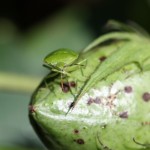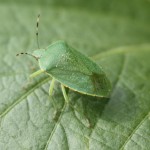There are two remaining Soybean Scout Schools scheduled for Tennessee (see below). These are field-side programs designed to give practical training on soybean management including insect, disease and weed control. Each program is 1.5 – 2 hours long. Participants will receive a scouting notebook and a sweep net while supplies last. Directions are Continue reading
Category Archives: Insects

Sampling for Plant Bugs and Stink Bugs
 Reports indicate that plant bug pressure has subsided somewhat, although nymphs are becoming more common. Earlier cotton is being treated for stink bugs in some places, but we generally seem to be in a little lull that is common in Tennessee around first bloom. The treatment threshold for tarnished plant bug and stink bugs is 3 and 1 bug(s) per drop cloth, respectively, once blooming begins. We’ve tested sampling approaches and treatment thresholds for plant bugs extensively throughout the Midsouth. There are several publications summarizing these results (see links below). Continue reading
Reports indicate that plant bug pressure has subsided somewhat, although nymphs are becoming more common. Earlier cotton is being treated for stink bugs in some places, but we generally seem to be in a little lull that is common in Tennessee around first bloom. The treatment threshold for tarnished plant bug and stink bugs is 3 and 1 bug(s) per drop cloth, respectively, once blooming begins. We’ve tested sampling approaches and treatment thresholds for plant bugs extensively throughout the Midsouth. There are several publications summarizing these results (see links below). Continue reading
Should You be Spraying Corn for Southwestern Corn Borers or Corn Earworm?
Based on our moth catches, this appears to be a good time for CONSIDERING an insecticide application to non-Bt corn for southwestern corn borer (SWCB). The reality is I cannot even hazard a guess on the question above unless I know a few things. Continue reading
Soybean – Be Alert for Fall Armyworm and Corn Earworm
Corn Earworm (a.k.a. bollworm) will feed on leaves, flowers and pods, but it is pod feeding that is the real concern. They can be a serious threat to soybeans beginning at R1 – R5, but they usually get started in earnest during full bloom (R2). The treatment threshold is 36 larvae per 100 sweeps. Fall armyworms will also feed on foliage and pods. Continue reading
Alerts for Soybean Insect Pests
 Stink Bugs. Very few fields are at R2 and R3 at this time, but stink bugs are concentrated is some of these early fields. We’ve been doing scout schools this week, and most of what I’ve been seeing is adult green stink bugs. This is the most common species in Tennessee. Normally, stink bug populations start building in earnest until R4 and R5. However, they sometimes concentrate in a few fields that are ultra early compared with the remainder of the crop. Treat anytime between R1-R7 when stink bug numbers average 36 or more per 100 sweeps. Continue reading
Stink Bugs. Very few fields are at R2 and R3 at this time, but stink bugs are concentrated is some of these early fields. We’ve been doing scout schools this week, and most of what I’ve been seeing is adult green stink bugs. This is the most common species in Tennessee. Normally, stink bug populations start building in earnest until R4 and R5. However, they sometimes concentrate in a few fields that are ultra early compared with the remainder of the crop. Treat anytime between R1-R7 when stink bug numbers average 36 or more per 100 sweeps. Continue reading
Second Generation Southwestern Corn Borers Flight Begins
Southwestern corn borer (SWCB) moths being caught in pheromone traps are starting to increase in some areas, especially those where there was a fair sized first generation flight. Expect to see moth catches increase dramatically over the next two weeks. I previously posted a detailed article about interpreting what these traps catches mean (link here). Below are a few bullet points for your consideration. Continue reading
Thinking Ahead on Plant Bugs and Stink Bugs
As we begin to bloom in our early planted cotton, it is time to consider options for controlling our typical complex of pests. Tarnished plant bug pressure has been continuous in some areas, and early indications are that stink bugs are also off to a good start. Here are some treatment options to consider Continue reading
Soybean Insect Update
There have been several more reports of threecornered alfalfa hopper (TCAH) infestations in seedling soybean where a high percentage of plants have been girdled. Plants less than 10 inches tall are susceptible to girdling. The girdling will not directly cause yield loss unless plants lodge. Lodging often occurs later in the season and especially where stands are thin. Please refer to my previous blog article about TCAH. Continue reading

